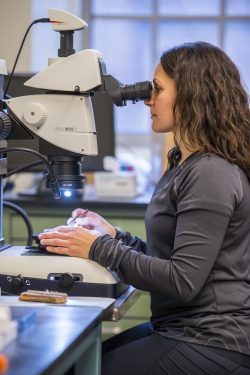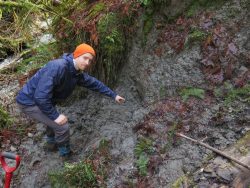“The important thing is not to stop questioning. Curiosity has its own reason for existing.” —Albert Einstein

Curiosity-driven research is scholarship in which real world applications are not immediately apparent. Such fundamental research can be seen as a luxury in a time where the College is called on to address a panoply of environmental challenges. Far worse is the fact that fundamental research in the geosciences is under fire in Washington, D.C. We disinvest in curiosity-driven research at our peril. Without it, our ability to understand the world—and address its very real problems—diminishes.
The most robust solutions to environmental problems are fortuitous offshoots of curiosity-driven research. A case in point is the recent work by professors Alison Duvall and Dave Montgomery (UW Earth and Space Sciences) assessing the risks of landslides in the aftermath of the devastating Highway 530 landslide near Oso, Wash. Duvall and Montgomery, along with Earth and Space Sciences graduate student Sean LaHusen and colleague Adam Booth (Portland State University), sought answers to the critical question of how often might we expect big slides like that to happen? To assess landslide risk, they needed to identify previous landslides and to precisely date the timing of their occurrence.
It turns out the tools they needed were outgrowths of fundamental research done in Earth and Space Sciences over the past several decades. Until recently it was nearly impossible to identify historic landslides on the forested slopes of the Cascades. A breakthrough came with the development of LIDAR (Light Detecting and Ranging) techniques, which use a very narrow laser beam to accurately measure the terrain underlying the trees. When LIDAR instruments are mounted in an aircraft with a sophisticated Global Positioning System (GPS) the result is maps that can detect features at an extremely high resolution. Using LIDAR to map surface landforms was pioneered by Dave Montgomery along with a group of US Geological Survey scientists who are Earth and Space Sciences affiliate faculty (Ralph Haugerud, Craig Weaver, Brian Sherrod). In the past several years this group has amassed numerous images for the Puget lowland.

Mapping landslides is not enough if we don’t know when they occurred. Here’s where the research of another Earth and Space Sciences faculty member comes in. In the 1980s Emeritus Professor Minze Stuiver, a geophysicist, played a lead role in calibrating radiocarbon and calendar ages. When Duvall and Montgomery discovered remains of trees topped by ancient landslides, precise radiocarbon dating let them distinguish between slides that were several centuries old versus several thousand years old. Combining the maps and the dates allowed them to conclude that Stillaguamish Valley has experienced large, long-runout landslides every few hundred years since the glacial ice sheets receded about 12,000 years ago. In other words, the 2014 Highway 530 landslide was not an extreme event in geologic terms, but simply the latest occurrence in an active history of slope failures throughout the last 12,000 years.
Neither LIDAR nor this type of precise radiocarbon dating were developed for the purpose of solving this environmental challenge. They were developed by scientists who, to the best of our knowledge, simply wanted to better understand how our world works.
This is just one example of many. When we talk about our research at the College and beyond, we often put ourselves in one camp or the other—research that’s curiosity-driven or applied towards solving problems. But in reality, they are inexorably linked, and are both motivated by our shared drive to discover. Let’s resist drawing a line between the two and arguing for the primacy of one vs. the other. They are both critical to the success of the College of the Environment and constitute the scientific toolkit we bring to understanding our world and to engaging with others in creating a sustainable future.
Lisa Graumlich
Dean, College of the Environment
Virginia and Prentice Bloedel Professor

